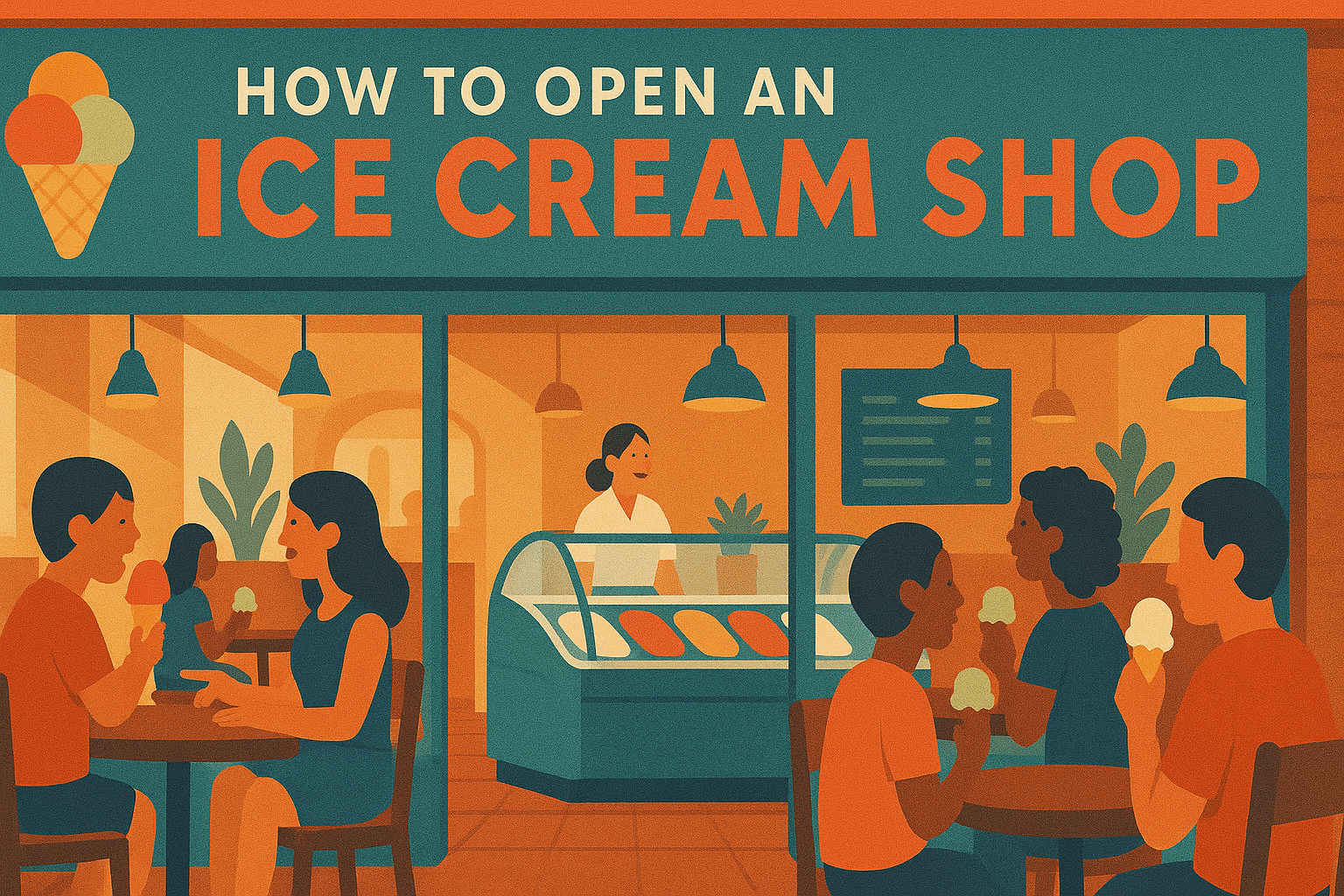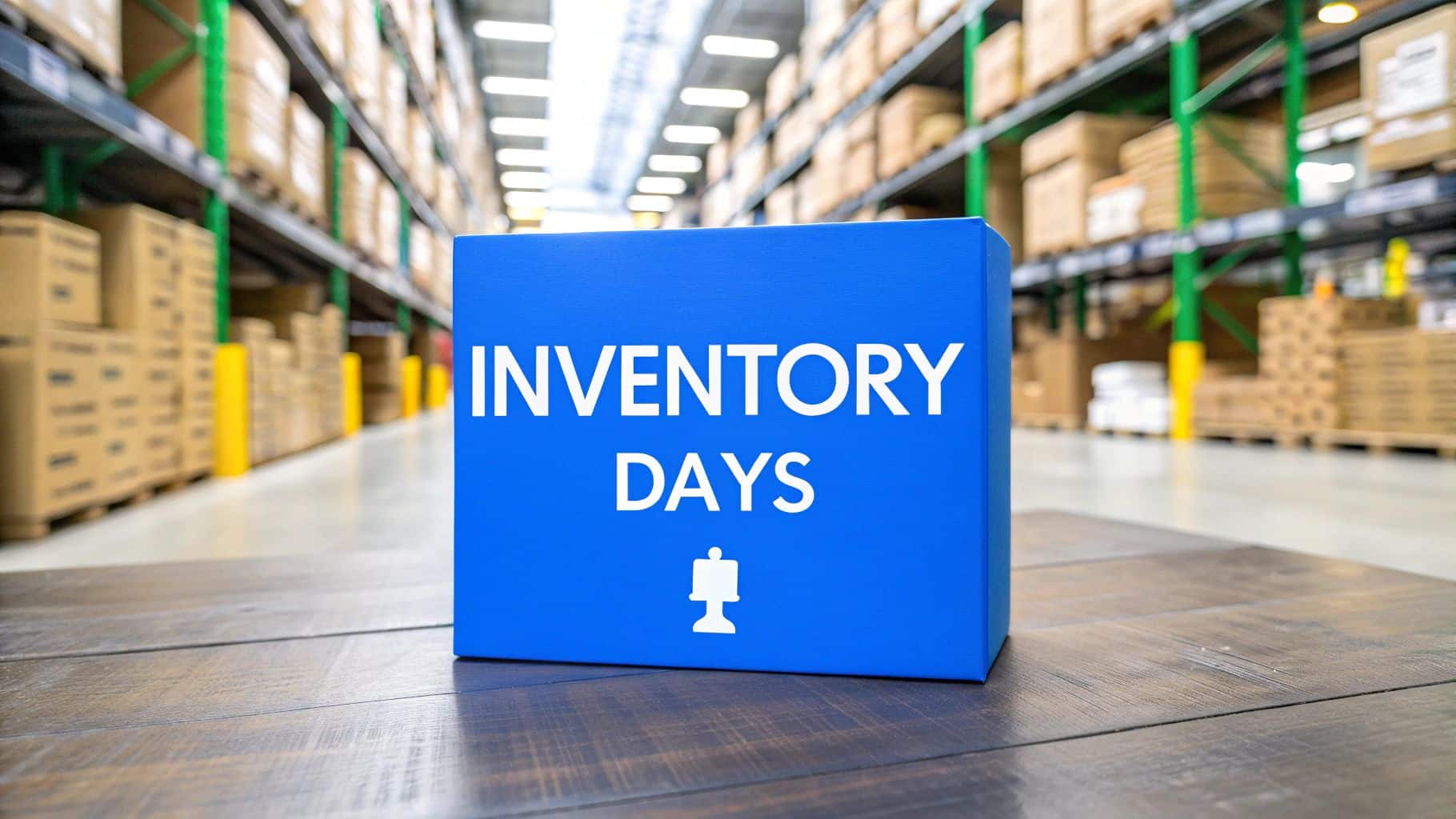Opening an ice cream shop is an exciting venture, filled with sweet potential. Whether you’re passionate about desserts or you’re simply looking to turn a love for ice cream into a business, it’s essential to plan and understand the intricacies of running an ice cream shop. From creating a solid business plan to selecting the right location, licenses, and permits, this guide will walk you through every step you need to take to open your ice cream shop successfully. Read on to learn everything about how to open an ice cream shop and set yourself up for long-term success.
Table of Contents
- Creating an Ice Cream Shop Business Plan
- Understanding Ice Cream Shop Licenses and Permits
- Selecting the Perfect Ice Cream Shop Location
- Calculating Ice Cream Shop Startup Costs
- Developing Effective Marketing Strategies for Your Ice Cream Shop
- Choosing Ice Cream Shop Equipment and Suppliers
- Building Your Ice Cream Shop Brand and Enhancing Customer Experience
- Hiring and Managing Ice Cream Shop Staff
- Understanding Insurance and Health Regulations
Creating an Ice Cream Shop Business Plan
Before diving into the operational aspects of opening an ice cream shop, having a well-thought-out business plan is essential. This plan serves as the foundation of your venture, guiding everything from financing to growth strategies. It outlines your business objectives, target market, pricing strategy, and marketing efforts. In addition, it helps secure investors or loans, so it’s important to be as detailed as possible.
Writing a Solid Business Plan
Creating a business plan for an ice cream shop starts by detailing your mission and vision. Are you offering traditional scoops, innovative flavors, or healthy options like dairy-free ice cream? Consider your unique selling points that set your shop apart from competitors. You will also need to research the ice cream market, including competitors and consumer preferences. This analysis will help shape your menu, pricing, and marketing strategies.
You’ll also need to identify your target market. Is your ice cream shop aimed at families, teenagers, or upscale dessert enthusiasts? Knowing your demographic helps in choosing the right location, designing your shop, and crafting a menu. A detailed marketing strategy should also be part of your plan, including how you’ll reach your audience through social media, promotions, and events.
Developing an Ice Cream Shop Menu
Your menu is one of the most critical elements of your ice cream shop business plan. Offering a variety of flavors and options is essential, but it’s also important to stay on top of trends. Seasonal flavors, limited-edition creations, or even collaborations with local businesses can create buzz around your shop. When developing your menu, think about both the products you want to offer and how you want to present them to customers.
Also, pricing your menu items correctly is crucial for profitability. Ensure that your prices cover the cost of ingredients, labor, overheads, and any unexpected expenses. However, they must also be competitive enough to attract customers while making your business sustainable.
Long-Term Business Growth and Strategy
While a solid business plan will get you started, it’s also essential to think about long-term growth. Whether you’re planning to open additional locations or franchise your ice cream shop, you should have a roadmap that includes expansion strategies, scaling operations, and customer loyalty programs. Continuously evaluating market trends and consumer preferences will allow you to adjust your strategies to ensure sustained success.
Consider implementing technology tools, like Biyo POS, to manage operations efficiently. From inventory management to tracking customer preferences, technology can streamline your business, making growth more manageable. This will allow you to focus on enhancing your customer experience and ensuring consistency across all aspects of your business.

Understanding Ice Cream Shop Licenses and Permits
Opening an ice cream shop requires more than just passion for ice cream—it also involves complying with local and national regulations. Obtaining the proper licenses and permits is essential to avoid legal trouble down the line. This section will guide you through the essential licenses and permits you’ll need to operate your ice cream shop legally.
Required Licenses for Ice Cream Shops
Depending on where you’re located, your ice cream shop will require various licenses. At a minimum, you’ll need a business license to operate legally. Additionally, food establishments often need a food handling license or permit issued by the health department. In many cases, you may also need a food establishment permit, which confirms that your shop meets food safety and sanitation standards.
For those selling ice cream on-site or at events, a vendor’s permit may also be necessary. It’s important to research your local regulations to ensure you’re not missing any essential documents. Consulting with a legal expert or local business development center can provide clarity on what your specific ice cream shop needs. This proactive approach can save you time and money down the line.
Permits and Health Regulations
Health and safety regulations are critical when operating an ice cream shop, as you’re dealing with food and beverages. Your local health department will require inspections of your premises, refrigeration systems, and overall cleanliness. You’ll need to follow strict guidelines to ensure that your shop meets food safety standards. These regulations may include handling, storage, and sanitation practices for dairy products, as well as staff hygiene protocols.
Besides general health regulations, you may also need specific permits for waste disposal and fire safety. These permits can vary by location, so it’s crucial to check with your local authorities to determine all the necessary steps to legally operate your ice cream shop. Each permit and regulation ensures the safety of both your customers and your business.
Insurance and Risk Management
To protect your business, investing in insurance is a must. The types of insurance your ice cream shop will require include liability insurance, property insurance, and worker’s compensation. Liability insurance protects your business from potential lawsuits related to foodborne illnesses or accidents that happen on the premises. Having comprehensive coverage helps reduce the financial risk to your business in case of an unforeseen incident.
Property insurance covers damages to the building, equipment, and inventory in case of unexpected events such as fire, theft, or natural disasters. Worker’s compensation is necessary to provide benefits for employees in case of work-related injuries. These insurance policies will help safeguard your ice cream shop from financial losses caused by unforeseen circumstances, ensuring that you can focus on growing your business without worrying about potential setbacks.
Selecting the Perfect Ice Cream Shop Location
Choosing the right location for your ice cream shop is crucial to its success. A prime location increases visibility, foot traffic, and the likelihood of attracting new customers. However, finding the right spot requires careful planning and market research. Let’s explore the key factors to consider when selecting the ideal location for your ice cream shop.
Analyzing Foot Traffic and Demographics
When selecting a location, foot traffic plays a significant role. High-traffic areas such as near parks, schools, or shopping malls are ideal for an ice cream shop. Locations with strong foot traffic mean more potential customers, increasing your chances of success. Pay attention to the neighborhood demographics as well—are they families with children, young professionals, or tourists? Understanding the area’s target market will guide your product offerings and marketing strategies.
In addition to foot traffic, you should analyze the surrounding businesses. If you’re located near a popular tourist destination or family-oriented businesses, you may have access to a broader customer base. Evaluate the existing competition in the area and ensure that your shop can stand out with a unique offering. By aligning your location with your target market, you increase the likelihood of attracting loyal customers.
Proximity to Competitors
While you want your ice cream shop to be in a bustling area, it’s also important to consider nearby competition. Evaluate the number of ice cream shops or frozen dessert establishments in the area. If there are already several shops, you may need to find ways to differentiate your business, whether through unique flavors, customer service, or seasonal promotions. On the other hand, if there are few options, you might have an untapped market to yourself.
It’s not always bad to have competitors nearby. In fact, having a few other ice cream shops in the area can help increase foot traffic to the location, especially if the area becomes known as an ice cream destination. However, you will need to ensure that your shop offers something special to attract customers away from competitors. Whether it’s offering better customer service, unique flavors, or a wider variety of options, standing out in a competitive area is key.
Rent and Lease Agreements
The cost of renting a commercial space varies significantly based on location. You’ll need to balance the ideal location with what you can afford. Be sure to read the lease agreement thoroughly to understand your obligations and ensure the terms are favorable for your long-term goals. The lease should provide flexibility in case you decide to expand or relocate in the future.
When evaluating a lease agreement, consider both the monthly rent and any additional costs such as utilities, maintenance fees, and insurance. Negotiating a fair lease agreement will allow you to manage your business’s operating expenses effectively. A long-term lease may offer stability, but be sure that you’re in a location with growth potential before committing to a long-term agreement.
Calculating Ice Cream Shop Startup Costs
Opening an ice cream shop comes with a variety of startup costs. These include rent, equipment, licensing fees, inventory, and staffing. Properly estimating these costs is vital for financial planning and ensuring you have enough capital to get started.
Equipment and Supplies
Ice cream machines, freezers, refrigerators, and display cases are some of the major equipment costs you’ll face. The quality of your equipment is essential, as it directly affects the quality of your product. Consider purchasing commercial-grade equipment that will withstand the demands of daily operation. Depending on your menu, you may need specialized machines, such as soft serve or gelato machines.
You’ll also need a steady supply of ingredients like cream, sugar, and flavorings, as well as toppings and packaging materials. Establishing relationships with reliable suppliers can ensure you have access to quality ingredients at reasonable prices. For this purpose, reaching out to local farmers and suppliers may also help reduce costs while supporting the community. Properly budgeting for supplies ensures that your shop is always stocked with the necessary ingredients to deliver quality products to your customers.
Labor and Operational Costs
Another critical part of your startup costs is labor. Wages for staff, training programs, and uniforms must be factored in. You’ll also need to budget for utilities such as electricity, water, and internet services. These ongoing operational costs should be tracked carefully to ensure that your ice cream shop remains financially viable. These costs can fluctuate depending on the size of your shop and the number of employees you need to hire.
Labor costs also include scheduling and staff management, which is especially important during busy seasons. Consider how much staff you need based on projected foot traffic. During peak hours, you’ll need more staff to handle orders efficiently. A solid payroll system will ensure you’re prepared to manage labor expenses effectively without sacrificing customer service quality.
Marketing and Branding Expenses
Developing a strong marketing strategy is crucial for attracting customers to your ice cream shop. From signage to social media advertising and promotions, it’s important to budget for marketing expenses. Creating a memorable brand identity, including logos, packaging, and store design, is another key investment to make your ice cream shop stand out in a crowded market. Consistent branding helps to create an emotional connection with your customers.
Also, consider online advertising and community events to boost visibility. Investing in digital marketing tools and platforms can help you track the effectiveness of your campaigns and adjust your strategies as needed. Whether through influencer collaborations, social media promotions, or local event sponsorships, effective marketing ensures that your ice cream shop gains traction and continues to attract new customers.
Developing Effective Marketing Strategies for Your Ice Cream Shop
Effective marketing strategies are essential for attracting customers and driving sales to your ice cream shop. Let’s explore several proven marketing techniques that can help you build a strong customer base and increase your shop’s visibility.
Social Media Marketing
Social media platforms like Instagram, Facebook, and TikTok are essential tools for promoting your ice cream shop. Share mouth-watering photos of your products, engage with customers, and promote special offers. Using hashtags and geotags increases your reach, and customer reviews and testimonials build trust and attract more visitors.
Social media is also a great way to showcase your ice cream shop’s personality. Post behind-the-scenes content, share customer stories, and highlight your seasonal flavors or limited-edition treats. Engaging with followers and responding to comments helps build a community around your brand, keeping customers loyal and engaged.
Seasonal Promotions and Events
Hosting seasonal events, like summer ice cream socials or winter-themed promotions, can bring in new customers and keep existing ones coming back. Offering discounts or limited-edition flavors for holidays or special occasions generates excitement and increases foot traffic to your store. Make sure to advertise these promotions in advance via social media, email newsletters, and local event listings.
Seasonal promotions also offer an opportunity to collaborate with local businesses for cross-promotions. For example, partner with a nearby bakery to offer ice cream sandwich specials or a local coffee shop to create a unique ice cream coffee drink. These types of collaborations can help build your reputation within the local community and expand your customer base.
Community Engagement and Partnerships
Engaging with your local community is key to creating a loyal customer base. Partner with local businesses or participate in community events to increase your brand visibility. Hosting charity events or offering discounts to local residents are great ways to connect with the community and build goodwill around your brand.
Being an active part of your community helps solidify your ice cream shop as a local favorite. Engage in sponsorship opportunities or offer support to local schools, fundraisers, and events. Community engagement not only promotes your business but also strengthens customer loyalty, leading to long-term success.
Choosing Ice Cream Shop Equipment and Suppliers
For your ice cream shop to run efficiently and consistently deliver quality products, choosing the right equipment and suppliers is essential. From ice cream machines to packaging, the right suppliers will help you streamline operations and maintain product quality.
Essential Ice Cream Shop Equipment
Your ice cream shop will require specialized equipment such as ice cream machines, freezers, and display cases. Choose high-quality machines to ensure smooth operation and the production of great ice cream. Depending on your menu, you may need specialized machines, such as soft serve or gelato machines.
It’s crucial to invest in durable equipment that can withstand the demands of high-volume service. Additionally, refrigeration units should be energy-efficient to help reduce operational costs. Make sure to factor these costs into your budget, as top-quality equipment is essential for providing a premium product that will keep customers coming back.
Selecting Reliable Suppliers
Finding dependable suppliers for ingredients and packaging is crucial to maintaining a consistent and high-quality product. Build strong relationships with suppliers who provide fresh, high-quality ingredients and who can meet your needs during peak seasons. Working with local suppliers for dairy and fruits can help ensure that you offer the freshest ingredients while supporting local businesses.
Choosing the right packaging suppliers is also important. Packaging that reflects your brand and keeps your products fresh will enhance the customer experience. Make sure your suppliers can deliver materials on time and within budget to ensure smooth operations. Good supplier relationships also allow for flexibility in case of supply chain issues.
Negotiating Contracts
Once you’ve found suitable suppliers, negotiate contracts to get the best deals on price and terms. Look for suppliers who are flexible and willing to work with you on delivery schedules and minimum order quantities. A reliable supply chain is crucial to your business’s success, so always evaluate your suppliers’ reliability before signing contracts.
Negotiating favorable contract terms ensures that you’re getting the best value for your money. Look for suppliers who offer competitive pricing without compromising on quality. Contracts should be clear, covering payment terms, delivery schedules, and any penalties for delays or quality issues.
Building Your Ice Cream Shop Brand and Enhancing Customer Experience
A strong brand identity and exceptional customer experience can set your ice cream shop apart from the competition. Let’s look at how you can build a memorable brand and provide a customer experience that keeps people coming back.
Creating a Memorable Brand
Building a strong, recognizable brand involves creating a unique logo, color scheme, and messaging that resonates with your target market. Ensure that your brand reflects the essence of your ice cream shop, whether that’s fun, high-end, or family-friendly. Your branding should be consistent across all marketing materials, from packaging to social media posts and in-store signage.
Your brand should evoke the feelings you want your customers to have when they visit your ice cream shop. Whether it’s nostalgia, indulgence, or a sense of adventure with unique flavors, your branding should connect with your target audience emotionally. Investing in professional design services can help bring your brand to life in a way that resonates with customers.
Designing a Welcoming Environment
Your shop’s interior design plays a key role in shaping the customer experience. Choose colors, furniture, and layouts that reflect your brand identity. Offering comfortable seating, clean surroundings, and a welcoming atmosphere will make customers feel relaxed and inclined to stay longer. An aesthetically pleasing shop increases the likelihood of customers taking photos and sharing their experience on social media.
Consider creating an Instagram-worthy corner with fun décor that encourages customers to take photos. High-quality lighting and visually appealing displays will attract attention, especially for those passing by. A well-designed store enhances the overall experience and encourages customers to linger and return.
Delivering Exceptional Customer Service
Providing top-notch customer service is vital for ensuring customers keep coming back. Train your staff to be friendly, knowledgeable, and attentive to customers’ needs. A simple smile and a willingness to go the extra mile can significantly enhance the overall customer experience. Offer loyalty programs, discounts for repeat visits, and personal touches like remembering customers’ favorite flavors to encourage brand loyalty.
Exceptional customer service goes beyond just fulfilling orders. It’s about creating a welcoming atmosphere where customers feel valued and appreciated. Offering personalized recommendations and engaging with customers in a friendly manner will encourage them to return. Building a strong customer relationship is key to the longevity of your ice cream shop.
Hiring and Managing Ice Cream Shop Staff
Hiring the right staff is key to running a successful ice cream shop. Your team needs to be not only skilled at serving customers but also knowledgeable about the products you offer. Let’s dive into the best practices for staffing and managing your ice cream shop.
Recruiting the Right Staff
Hiring the right team starts with clear job descriptions and effective recruitment strategies. Seek individuals who are passionate about ice cream and customer service. Look for candidates who are friendly, reliable, and able to multitask efficiently in a busy environment. A well-rounded team can make your shop run smoothly and provide an exceptional customer experience.
In addition to customer service skills, staff should also be knowledgeable about food safety and hygiene. Look for candidates who are adaptable, able to work in a fast-paced environment, and are willing to learn new skills. Offering competitive wages and benefits can help you attract talented staff and reduce turnover.
Training Your Staff
Once you’ve hired your team, providing proper training is essential. Staff should be trained in food safety, customer service, and how to use your point of sale systems. Offering refresher courses and ongoing training can help improve team performance and morale. Ongoing training ensures that your staff maintains high service standards and stays updated on any new product offerings.
Providing your team with clear expectations and the tools they need to succeed will create a motivated and efficient workforce. Additionally, investing in customer service training will ensure that your team can handle any situation with grace, leading to satisfied and loyal customers.
Managing Your Team
Effective management involves setting clear expectations and maintaining a positive workplace culture. Regularly check in with your team, provide constructive feedback, and motivate them to do their best. Strong leadership can lead to high staff retention and a more efficient, productive ice cream shop.
Creating a supportive environment where employees feel valued encourages them to stay with your business long-term. Implement performance incentives, encourage open communication, and provide growth opportunities. When your team feels motivated and appreciated, they will deliver the best possible customer experience.
Understanding Insurance and Health Regulations
Ensuring compliance with insurance and health regulations is crucial when operating an ice cream shop. Let’s explore the key insurance and health regulations that apply to your business.
Health and Safety Standards
Ice cream shops are subject to health and safety regulations that vary by location. These include guidelines for food preparation, storage, and sanitation. Make sure your business complies with local health department regulations, including regular inspections and adherence to safety protocols. Keeping your space clean and your staff properly trained in health and hygiene is essential.
Regularly review and update your food safety practices to stay in line with the latest health codes. Train your staff on proper handling and storage procedures to minimize the risk of contamination. A safe, clean environment not only keeps your customers healthy but also builds trust in your business.
Insurance Coverage
In addition to health regulations, you’ll need various types of insurance. Liability insurance protects against accidents or injuries on your property, while property insurance covers damages to your store or equipment. Worker’s compensation insurance is required to cover any injuries employees may sustain while working in your ice cream shop.
Insurance is a necessary investment to protect your ice cream shop from unexpected situations. Make sure your insurance coverage is comprehensive enough to cover a range of risks, from property damage to employee injuries. Consulting with an insurance professional can help you choose the best coverage for your business needs.
Employee Training on Health Standards
Proper training of your employees is essential to ensure your ice cream shop meets health standards. Teach your team the importance of personal hygiene, food handling, and equipment maintenance to reduce the risk of contamination. Regularly review and update training procedures to stay in line with evolving health regulations.
Regular health and safety training ensures that your team is always prepared to handle food safely. Encourage a culture of cleanliness, and make sure employees are aware of the risks of foodborne illnesses. Providing ongoing training also helps maintain high operational standards and supports your business’s reputation for quality and safety.

About Biyo POS
Opening an ice cream shop can be a rewarding and profitable business venture if approached with careful planning and consideration. From creating a solid business plan to selecting the right location, obtaining licenses, and providing excellent customer service, there are many steps to ensure your shop’s success. By implementing effective marketing strategies, choosing the right equipment and suppliers, and maintaining high standards for health and safety, your ice cream shop can become a beloved local business.
If you’re looking to streamline operations and enhance customer experience, Biyo POS offers a comprehensive solution to manage inventory, track sales, and optimize business performance.
FAQ
How much does it cost to open an ice cream shop?
The cost to open an ice cream shop can vary widely depending on the location, size of the shop, and equipment needed. On average, startup costs can range from $50,000 to $300,000 or more. These costs include rent, equipment, permits, inventory, marketing, and staff.
Do I need special permits to sell ice cream?
Yes, you will need to obtain food handling licenses, business permits, and health permits to legally operate an ice cream shop. Make sure to check with your local health department and business authorities to ensure you’re fully compliant with regulations.
What are some successful marketing strategies for an ice cream shop?
Successful marketing strategies include using social media platforms to promote special offers, hosting seasonal promotions, partnering with local businesses, and creating a strong, memorable brand. Offering loyalty programs and engaging with your community can also help boost customer retention.




